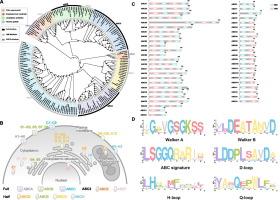Genome-wide identification, docking and expression analysis of ATP-binding cassette gene family of Parnara guttata, a major rice pest (Insecta: Lepidoptera: Hesperiidae)
IF 2.2
2区 生物学
Q4 BIOCHEMISTRY & MOLECULAR BIOLOGY
Comparative Biochemistry and Physiology D-Genomics & Proteomics
Pub Date : 2025-09-17
DOI:10.1016/j.cbd.2025.101635
引用次数: 0
Abstract
ATP-binding cassette (ABC) transporter family, is one of the largest and most ancient classes of transmembrane protein. Rice skipper, Parnara guttata, is a major rice pest distributed across China, Japan, and South Korea, and damages rice crop by rolling leaves into shelters, resulting in complicated pest control efforts. In this study, we performed genome-wide identification, docking and expression analysis of ABC transporters in P. guttata, and identified 47 ABC transporter genes. Phylogenetic analysis classified these genes into eight subfamilies (ABCA-H). Molecular docking revealed that transporters with the strongest binding affinities for Bt toxin Cry1Ac and chemical pesticides (cypermethrin, imidacloprid, malathion) predominantly belonged to the ABCC and ABCG subfamilies, suggesting these as potential pesticide targets. Transcriptomic data showed that all ABCD, ABCE, and ABCF genes were highly expressed in larval midguts, while other subfamilies exhibited partial high expression. These findings provide critical insights for toxicological studies and evolutionary analyses of ABC transporters in invertebrates.

水稻主要害虫古田鼠atp结合盒基因家族的全基因组鉴定、对接及表达分析(昆虫纲:鳞翅目:夜蛾科)
atp结合盒(ABC)转运蛋白家族是跨膜蛋白中最大和最古老的一类。稻谷跳虫(Parnara guttata)是一种主要的水稻害虫,分布在中国、日本和韩国,它通过将水稻叶片卷进庇护所来破坏水稻作物,导致复杂的害虫防治工作。在本研究中,我们对古塔麻ABC转运蛋白进行了全基因组鉴定、对接和表达分析,鉴定出47个ABC转运蛋白基因。系统发育分析将这些基因分为8个亚家族(ABCA-H)。分子对接发现,对Bt毒素Cry1Ac和化学农药(氯氰菊酯、吡虫啉、马拉硫磷)结合亲和性最强的转运体主要属于ABCC和ABCG亚家族,提示它们是潜在的农药靶点。转录组学数据显示,ABCD、ABCE和ABCF基因在幼虫中肠全部高表达,而其他亚家族部分高表达。这些发现为无脊椎动物ABC转运体的毒理学研究和进化分析提供了重要的见解。
本文章由计算机程序翻译,如有差异,请以英文原文为准。
求助全文
约1分钟内获得全文
求助全文
来源期刊
CiteScore
5.10
自引率
3.30%
发文量
69
审稿时长
33 days
期刊介绍:
Comparative Biochemistry & Physiology (CBP) publishes papers in comparative, environmental and evolutionary physiology.
Part D: Genomics and Proteomics (CBPD), focuses on “omics” approaches to physiology, including comparative and functional genomics, metagenomics, transcriptomics, proteomics, metabolomics, and lipidomics. Most studies employ “omics” and/or system biology to test specific hypotheses about molecular and biochemical mechanisms underlying physiological responses to the environment. We encourage papers that address fundamental questions in comparative physiology and biochemistry rather than studies with a focus that is purely technical, methodological or descriptive in nature.

 求助内容:
求助内容: 应助结果提醒方式:
应助结果提醒方式:


